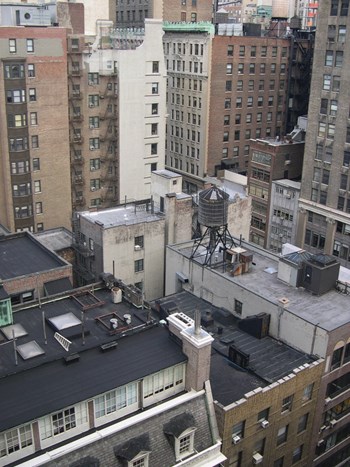
“Up On the Roof” is the title of a famous 1960s song by The Drifters about two New York inner-city lovers who go up to the roof just to get away from the “hustling crowd.” There’s a lot of romantic connotation to New York City’s rooftops—but how many people really know, or care, what’s up there?
Most apartment dwellers never venture up to the roof, sometimes called the forgotten “fifth wall” of the building. Indeed, they are usually not allowed to do so—unless, of course they’re lucky enough to have a finished roof deck or “green roof.”
Most New York City apartment buildings have flat roofs, but the material varies, often depending on how old the roof is. According to Wayne Bellet of Bellet Construction Co. in Manhattan, older buildings usually have multiple-layer roofs that were made with “layer upon layer of hot tar, felt, hot tar, felt, and so on, finished [when it’s done nowadays] with either gravel or a membrane.” Although this type of roofing is sometimes still used, Bellet says “It’s largely been superceded by today’s technology.”
A wide variety of roof products are used to construct today’s roofs. One popular material is modified bitumen, an asphalt-type substance that has had modifiers added to it to give it plastic or rubber-like properties.
“The beauty of modified bitumen,” says Bellet, “is that is that has a polyester core, which is very durable. If you remember back when we wore polyester, it was almost immune to tears and splits.” Same goes for polyester roofing products as well—though they don’t come in as many festive patterns.
Other products mentioned by roofing contractors interviewed for this article include applied-liquid roof systems, which can be acrylic as well as polyester; ethylene propylene diene terpolymer (EPDM), rubber roofing membrane; polyvinyl chloride (PVC), vinyl roof membranes; and thermoplastic polyolefin membrane (TPO), another type of roof membrane material. Clearly, there are many modern synthetic materials out there that can be used for roof construction.
Form and Function
As to why pitched, or sloped, roofs are rarely used in New York City apartment houses, “It’s a combination of design and economics,” says Ronald Taylor of All-Star Roofing in Amity Harbor. “It’s cheaper to build a flat roof.”
When a roof is built, according to David Zanolli of Centimark Corp., with offices in New York and Roselle, New Jersey, it’s usually installed on top of a concrete, steel or wooden deck, with a level of insulation in between this deck and the roof system.
No matter how it looks to the average person, an apartment-building roof is not completely flat—there is a slight pitch, which could be several inches, toward the drainpipe, so that rain water will flow toward the drain, adds Kiki Sela of General Roofing and Restoration in Brooklyn. The drain can either be internal, or can run down the outside of the building.
What are the most vulnerable parts of a roof system? Usually, those places where outside elements meet the roof per se, or where the plane of the roof is interrupted. These can include masonry, parapet walls (the portion of the facade that continues above the roof line, forming a low wall at the edge of the roof), pipes, doorways, drains, air conditioning towers, skylights, and flashings (the protective metal installed at the intersection of the roof itself and these types of structures to keep them watertight).
“The most important roof of the building,” says Bellet, “is the roof to the elevator building. This is a little tiny roof that contains a half-million to a million dollars worth of equipment. No one goes up to see it, but God forbid you get a leak there.”
Lack of Maintenance
Some common problems that can harm a roof are clogging around the drains, penetration of water into the roof itself, and even pigeon debris. But the most common problem, says Bellet, is a simple lack of maintenance.
“It’s astounding to me how people will invest hundreds of thousands of dollars in a roof and then never maintain it,” he says. “They don’t clean the drains, they don’t install protective walkway pads for tradesmen [who need roof access]. Every year after the Fourth of July, you can find bottle rockets, beer cans and soda cans up on the roofs. They just don’t maintain them.”
And add to that the damages caused by some of the aforementioned tradesmen, especially those who aren’t roofers. For example, “Say someone from the cable company comes and puts an antenna through the roof,” says Taylor. “He may pop something through the roof without knowing how to repair the damage.”
If a roof is properly maintained, it can last quite a long time. Roofing systems, of course come with different designs, materials and warranty periods.
“You can easily get a roof to last 20, 25 or 30 years,” says Bellet. “But if you are using tradesmen who are unqualified and unsupervised, you’ll get a week out of it—if you’re lucky.”
Inspections
How often should roofs be inspected? Experts agree that at a minimum, inspections should be performed once a year. Mike De Maio of Manhattan-based Brian D. Goe Roofing recommends that they be inspected at least twice, once in the spring and once in the fall.
Spring and fall are both critical times because stray leaves and debris from nearby trees and plants can clog up the drains and, in the words of Taylor, “turn your roof into a swimming pool.”
Once they’re on the roof, inspectors look for conditions like cracks, tears, alligatoring (a condition in older roof membranes in which oxidation and the loss of vital oils produce a pattern of cracks resembling alligator hide) buckles (bends, crumples or curls), or blisters indicating trapped air and/or moisture in the roof material. They also look for signs of damage to flashings and seams; debris on the roof; and, in general, signs of water entry or seepage beneath the roof system.
The masonry walls, say experts, should also be inspected, as should, of course, the drains. In addition, the roof should be examined for any sign that unauthorized people have been up there.
How much does a professional roof inspection cost? Those interviewed for this article have given a wide range, from $150 to $1,200. Bellet, who specializes in the exterior of buildings in general, says he does these inspections for free. “If they don’t need me now, maybe someday they will,” he says.
Bringing in Your Building Staff
While professional roofing contractors are important, a co-op or condo’s building staff can also play a vital role in helping to maintain the roof in good condition. They can inspect the drains, inspect the caulking on the masonry walls to make sure water isn’t getting through, make sure the flashings are in good condition, and make sure HVAC repair people or cable installers follow proper procedures when they go up to the roof. They can also make sure no one has put any unauthorized decks or chairs there.
If the roof isn’t open to the public, Bellet recommends putting an alarm system at the entrance to the roof, with keys being given only to authorized personnel. One shareholder interviewed for this article recalls that when he was living in a studio apartment in the early ‘90s, the management put such an alarm at the roof’s entrance after one co-op owner was suspected of tampering with the TV cables.
More commonly, people tend to go up to the roof to have parties or sunbathe, to set off firecrackers on holidays, or—in some cases—for criminal mischief, or as a getaway route.
Clearly, some roof problems can be handled by the co-op or condo’s building staff, while some need the attention of a professional. The line between the two can depend on the building personnel and how they are trained.
“If any staff member doesn’t have the knowledge, he shouldn’t do it,” warns Sela. “Don’t just use tar on top of everything. If you have a problem in an EPDM roof and you use tar, you just ruin the roof more.”
“I go to many well-run buildings where their staff are as trained as some of my people,” says Bellet. “I go to others, and they don’t even know how to open a can of tar.”
Green Roofs
As we’ve mentioned, in some apartment buildings, the management or board decides to furnish the roof with decking, plants and recreational furniture, or cover it entirely with plants and ground cover to cut energy costs—a type of roof treatment known as a “green roof.” But this can create new problems.
Planters and tables should be firmly fastened to protect against high winds that could take them off the building and, in the worst scenario, injure people walking below. A walking surface or pathway should be installed so people aren’t walking right on the roof. The decking should also not be installed right on top of the drain, for obvious reasons.
“Sometimes, people install a new deck over an old roof that has one or two years to go,” says De Maio. Sela adds the roof has to be waterproofed, and that the chairs and other furniture should be put on the walkways, not on the roof itself, where they could eventually create holes in the surface.
In general, if your co-op or condo wants to create a green roof, management should consult and collaborate with professionals.
To sum up, although the roof isn’t the most high-profile area of an apartment building, it’s very critical. Your roof is the one thing protecting your shareholders from snow, rain, and leaks—something so expensive, hardworking, and fragile needs regular checkups and year-round TLC.
Raanan Geberer is a freelance writer and a frequent contributor to The Cooperator.





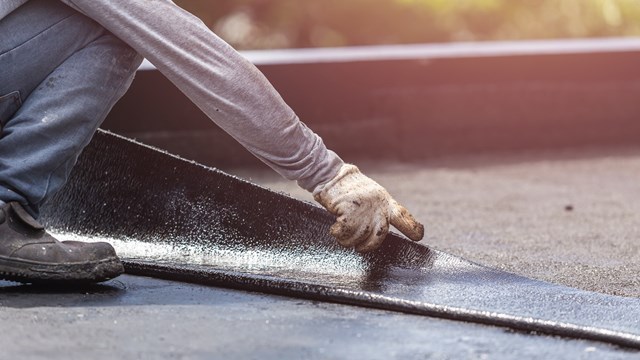
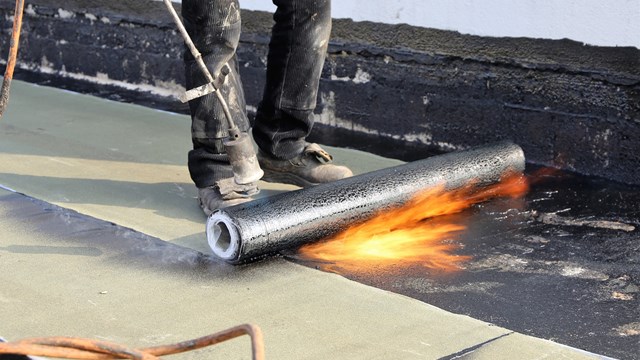
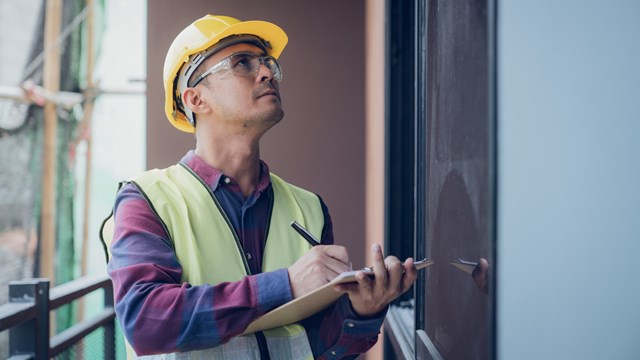
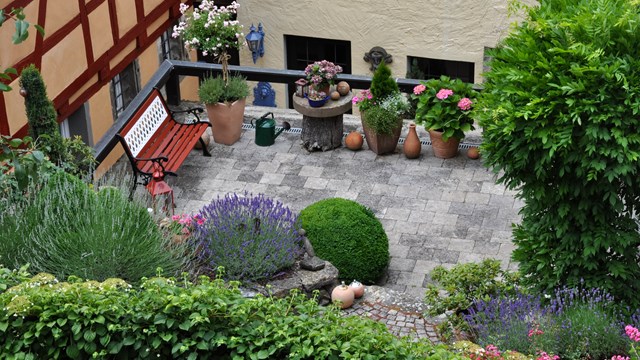
Leave a Comment